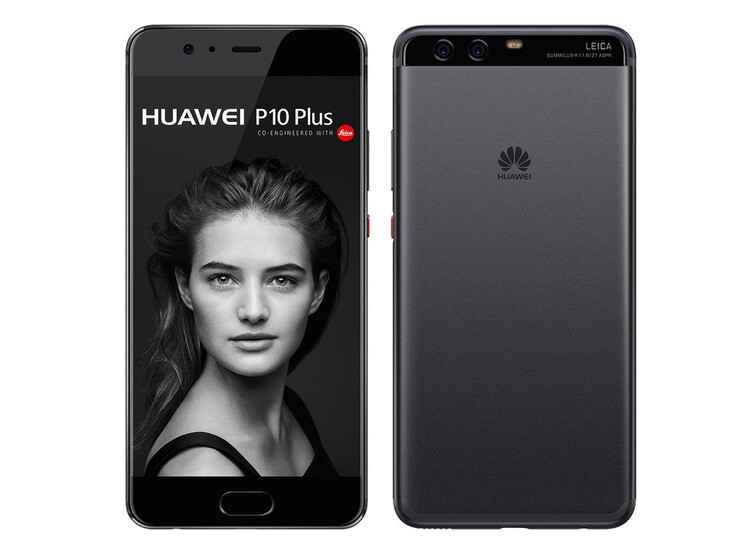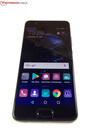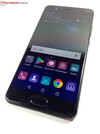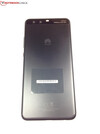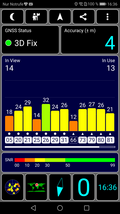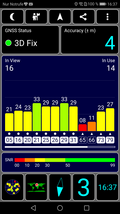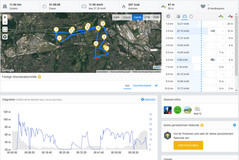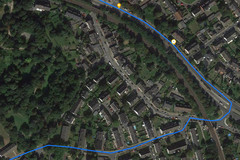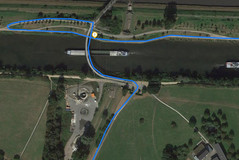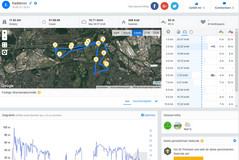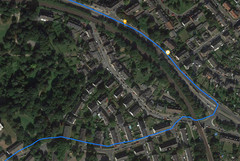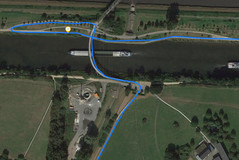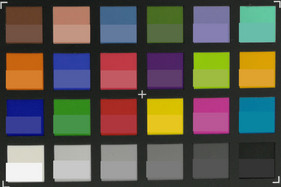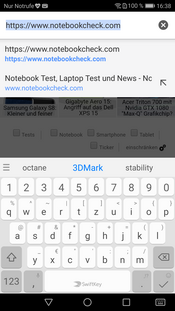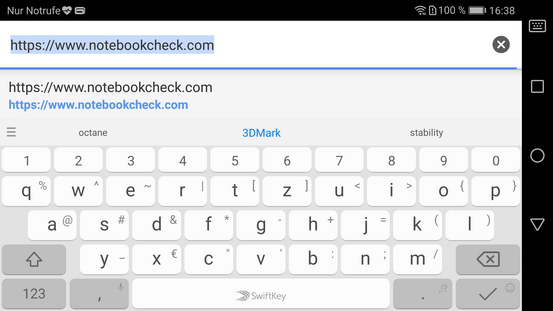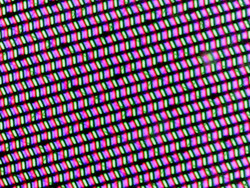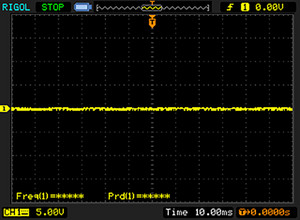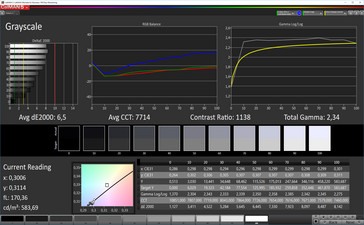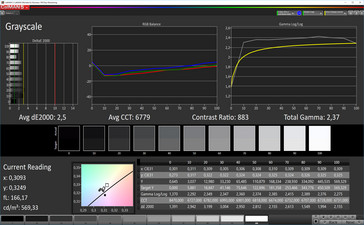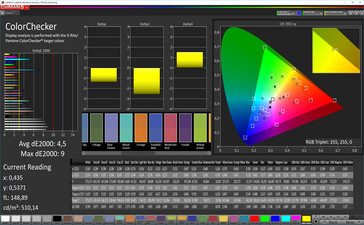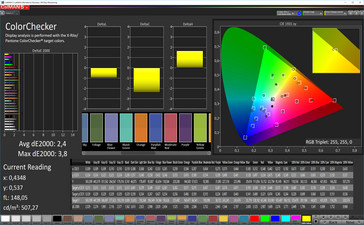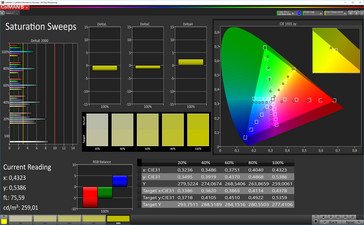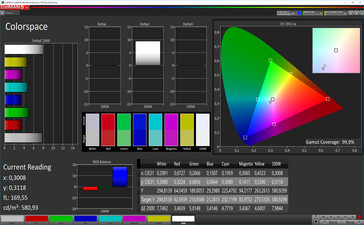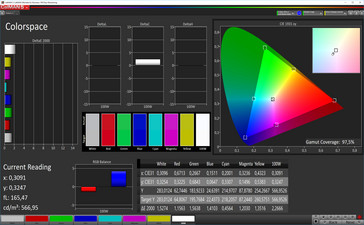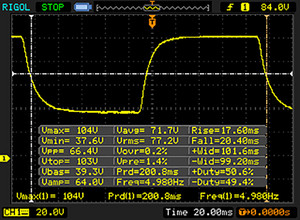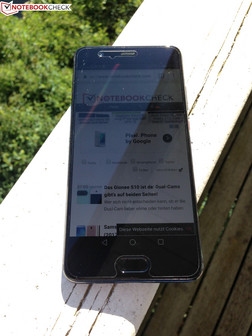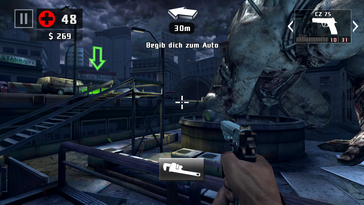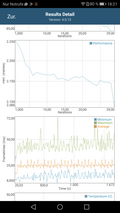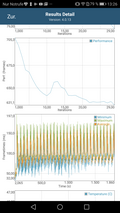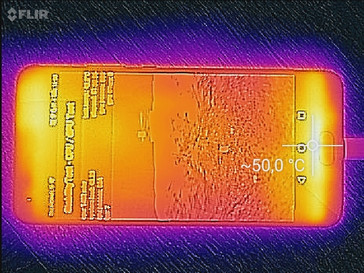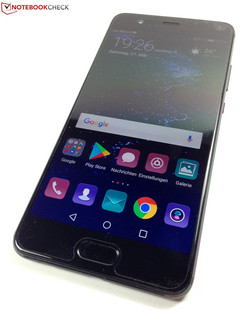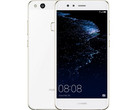Huawei P10 Plus Smartphone Review

For the original German review, see here.
With the P10 Plus, Huawei offers an improved version of its P10 high-end smartphone. The most visible difference: Rather than 5.1 inches and a Full HD screen, the P10 Plus has a screen diagonal of 5.5 inches and a WQHD resolution (2560x1440 pixels). It is also "bigger" inside, even though Huawei has not changed the SoC (HiSilicon Kirin 960) or the graphics chip (ARM Mali-G71 MP8). However, the RAM has been increased by 2 GB now to 6 GB and the internal storage is twice the size with 128 GB rather than 64 GB. The Leica dual camera installed into the P10 Plus now has the higher-quality and more light-sensitive Summilux instead of the Summarit lenses. And last but not least, Huawei has also increased the battery's capacity by 550 mAh to 3750 mAh.
The only question left is whether these updates justify the high surcharge compared with the "normal" Huawei P10 - Huawei is officially asking 749 Euros (~$700) for its P10 Plus. We put it to the test and let Huawei's P10 Plus compete against the P10 and the following premium-range models: the Apple iPhone 7 Plus, the Lenovo Moto Z, the LG G6, the OnePlus 3T and the Samsung Galaxy S8+.
Memory performance differences: As with the Huawei P10 and Mate 9 (we reported), it is a game of chance which storage is installed into Huawei's P10 Plus smartphone: The buyer gets either a fast UFS 2.1 storage as in our case, or is served with the relatively slow eMMC 5.1 storage. It is only roughly half as fast as the UFS 2.1 storage, which might be noticeable in slower app installations. Unfortunately, this game of chance also applies to the RAM (LPDDR3 or LPDDR4), but the impact here is not as significant as with the UFS/eMMC issue.
Case
As with the smaller Huawei P10, it is obvious that Huawei's P10 Plus is a premium-range smartphone from every perspective. The 5.5-inch aluminum casing merges seamlessly into the Corning Gorilla Glass screen that features a three-dimensional curve at the edges and in the corners. A fingerprint scanner is incorporated underneath the glass surface just like in the P10.
The smartphone not only feels good thanks to its design and the selected materials, but also convinces with high ergonomics. Despite its size of 5.5 inches, the P10 Plus is still comfortable to hold even for a prolonged time. The relatively low weight of 165 grams (~5.8 oz) and, as with the P10 (144 grams/~5.1 oz) low height of just below 7 millimeters (~0.3 in) have a significant part in this.
Thumbs up also for stability: The chassis of the P10 Plus can only be warped very slightly with some effort. The WQHD screen proved to be just as resistant to our pressure tests; they only caused a minor wave formation on the screen at most. A small point of criticism is found after all: The P10 Plus cannot offer an IP certification against dust and water that is now standard among the premium-range competition but like the P10 has only a nano-finish against moisture.
Huawei offers its smartphone in five colors. Our review sample's color is called Graphite Black. Other available colors are Mystic Silver, Dazzling Blue, Dazzling Gold, and Greenery. By comparison, Huawei's P10 comes in four colors: Mystic Silver, Graphite Black, Prestige Gold, and Dazzling Blue.
Connectivity
Huawei only sells the P10 Plus as a single-SIM model (nano-SIM slot) in Germany. Other countries are treated to a dual-SIM version with a hybrid slot. The other communication standards, i.e. Wi-Fi 802.11ac, Bluetooth 4.2, and NFC are the same in all versions.
The 128 GB storage in the P10 Plus can be expanded by up to 256 GB via a microSD card. However, the microSD card can only be used for saving photos and other media data because apps cannot be moved to it.
As with the Huawei's P10, the USB Type-C port supports only USB 2.0 speeds, but it supports USB OTG and can thus be used for connecting USB storage devices and other peripherals. The user can choose whether the smartphone is only to be recharged or be used as a removable media device when it is connected to a computer. Independent of that, the software HiSuite is available when connected to a virtual drive. It enables updating the handset and creating backups.
The P10 Plus has two unique selling points to offer compared with Huawei P10: Instead of a mono speaker, the P10 Plus features stereo speakers. Furthermore, only the P10 Plus has an infrared transmitter that allows using the smartphone as a remote for TVs, projectors or DVD players, for example. The corresponding app called Smart Controller is already preloaded for this.
Software
The software configuration is still the same as in Huawei's P10: Android 7.0 Nougat also powers the P10 Plus. Huawei covers it with its own EMUI 5.1 user interface. Google's security patches on our review sample were dated February 1st 2017, which is relatively up-to-date.
The enormous storage consumption that we observed in the P10 caused by EMUI 5.1 and its additional software has even increased in the P10 Plus. Of the nominal 128 GB of storage, only 109 GB is left in factory state. Just the firmware alone reserves a total of 16 GB. The preloaded apps also demand their share of storage.
Communication and GPS
With its abundant frequency configuration - four GSM, seven UMTS, and 19 LTE bands - Huawei's P10 Plus will find a connection to virtually every mobile network and always provided us with a strong signal in the test. Thanks to LTE Cat.12, maximum data transfer speeds of up to 600 MBit/s are possible.
The wireless transmission over a short range does not look quite as good. Although the P10 Plus features cutting-edge protocols in form of Wi-Fi 802.11ac, NFC, and Bluetooth 4.2, it is not reflected in the Wi-Fi performance like already in Huawei's P10. It achieved only 128 MBit/s in transmit and just 40.8 MBit/s in send in conjunction with our Linksys EA8500 reference router despite the fact that the P10 Plus has all the requirements for fast Wi-Fi transmission and supports the 5.0 GHz network in addition to the 2.4 GHz network. Thus, it even undercuts the hardly superior Huawei P10 and does not stand a chance against high-end rivals, such as Samsung's Galaxy S8 Plus or LG's G6.
| Networking | |
| iperf3 transmit AX12 | |
| Samsung Galaxy S8 Plus | |
| Huawei P10 | |
| OnePlus 3T | |
| LG G6 | |
| Huawei P10 Plus | |
| iperf3 receive AX12 | |
| Samsung Galaxy S8 Plus | |
| LG G6 | |
| Huawei P10 | |
| OnePlus 3T | |
| Huawei P10 Plus | |
Huawei's P10 Plus finds its current position via GPS, GLONASS, Galileo, and BeiDou (BDS). It managed to do this quickly indoors and as expected, was even faster outdoors. The achieved accuracy is the same: The P10 Plus tracked us with an accuracy of 4 meters (~13 ft). It could also compete very well with Garmin's Edge 500 professional navigation system on our 12-kilometer (~7.4 mi) bike ride. Apart from minor deviations, the P10 Plus was always on track and only logged an overall 100-meter shorter total route than the Edge 500.
Telephony and Call Quality
Huawei's P10 Plus supports calls with a high call quality. We were impeccably understood when we held the smartphone to the ear or used hands-free mode. The contact's voice was also always clear.
Cameras
At a first glance, the camera modules in Huawei's P10 Plus seem to be the same as in Huawei's P10: As usual, a dual-camera by Leica that is made of a 12 MP RGB module and a 20 MP monochrome lens is on the front. An 8-MP camera is situated on the rear.
However, the P10 Plus has the nominally better camera equipment: Rather than Summarit lenses (f/2.2) that are found in the P10, Huawei relies on the more light-sensitive Summilux lenses with an aperture of f/1.8 for its Plus model. The larger aperture of the Summilux lenses provides a higher image quality, at least on paper. The f/1.8 aperture allows capturing objects faster and should result in higher image sharpness and lower motion blurriness.
Huawei's P10 already shoots really good photos, but the image quality of Huawei's P10 Plus is even a bit better. The differences are not as big as one might presume, though. Both cameras are virtually on par in ideal light conditions. The high image sharpness and high range of dynamic in the test photos is convincing. The P10 Plus first shows slight advantages in low-light due to its smaller aperture - with emphasis on the slight. Low-light photos seem a bit sharper and more defined and do not display as much image noise.
The camera software is identical to that of Huawei's P10, and thus we would refer to its extensive test that also describes the functionality of Leica's dual-camera extensively.
We examined the dual camera in Huawei's P10 Plus a bit closer under defined light conditions. For this, we first photographed X-Rite's ColorChecker Passport to analyze the color accuracy. The photos are not edited afterward and filters are not applied. We then photographed our test chart under identical conditions.
As with Huawei's P10, the P10 Plus saturates the colors a bit too much, which makes the photos look slightly too warm rather than color neutral. Black is also a bit too rich and leads to high contrasts. The P10 Plus delivers just as good results as the P10 in terms of image sharpness. The sharpness decreases toward the image edges, but this is not unusual even for professional cameras.
Accessories and Warranty
Huawei includes a transparent cover, headset, USB cable (Type-C to Type-A), SIM tool, quick start guide, and a modular power supply for its P10 Plus. The latter has an output of up to 22.5 watts (5.0 V/2.0 A, 4.5 V/5.0 A, 5.0 V/4.5 A). Various flip cases are offered as optional accessories.
The P10 Plus comes with a 24-month warranty that can be extended to 36 months after registering the smartphone via the HiSuite app. VIP members then receive a screen and product replacement warranty that is only valid for the first 3 months after purchase. Please see our Guarantees, Return policies and Warranties FAQ for country-specific information.
Input Devices and Handling
Disregarding the sometimes slightly lower benchmark performance compared with Huawei's P10, which are mainly due to the larger and higher resolution screen, Huawei's P10 Plus is especially one thing: extremely fast. The smartphone responds instantaneously to all inputs - no matter if they are made on the very pleasant-to-the-touch 10-point touchscreen, the front-sided fingerprint scanner or both physical keys that provide a strong and at the same time very accurate feedback.
The fingerprint scanner's positioning might not appeal to everyone. It might sometimes make handling a bit more difficult when the smartphone is held in only one hand, such as scrolling through the gallery. As with Huawei's P10, the sensor identifies scanned fingerprints very quickly and reliably. Many convenient features, such as a glove mode, pocket mode or Knuckle Touch that, for example, allows making screenshots contribute to intuitive handling. The preloaded SwiftKey keyboard can be easily replaced by another keyboard from Google's Play Store. The home button can completely replace the Android onscreen buttons.
The IPS screen in Huawei's P10 Plus has a resolution of 2500x1440 pixels (WQHD). This results in an enormous pixel density of 540 PPI at a diagonal of 5.5 inches. Huawei's P10 "only" uses the Full HD resolution with 432 PPI. However, its contents are displayed just as sharply.
The good screen of the P10 is in no way inferior to the panel in Huawei's P10 Plus - it even delivers a somewhat better image quality. This should not be noticed much in routine use since the differences are overall very insignificant.
With an average of 561.1 cd/m², the screen in our review sample is a bit brighter (P10: 556.4 cd/m²) and its illumination of 92% is also 6% better. When repeating the measurement based on a realistic test with equally distributed bright and dark image areas on the screen (APL50), the P10 Plus once again achieves a slightly better rate with a maximum of 552 cd/m². The P10 Plus also has a slight lead in terms of contrast ratio and black value.
| |||||||||||||||||||||||||
Brightness Distribution: 92 %
Center on Battery: 568 cd/m²
Contrast: 1321:1 (Black: 0.43 cd/m²)
ΔE ColorChecker Calman: 2.4 | ∀{0.5-29.43 Ø4.78}
ΔE Greyscale Calman: 2.5 | ∀{0.09-98 Ø5}
Gamma: 2.37
CCT: 6779 K
| Huawei P10 Plus LTPS, 2560x1440, 5.5" | Apple iPhone 7 Plus IPS, 1920x1080, 5.5" | Huawei P10 LTPS, 1920x1080, 5.1" | OnePlus 3T Optic-AMOLED, 1920x1080, 5.5" | Samsung Galaxy S8 Plus Super AMOLED, 2960x1440, 6.2" | LG G6 IPS LCD, 2880x1440, 5.7" | Lenovo Moto Z AMOLED, 2560x1440, 5.5" | |
|---|---|---|---|---|---|---|---|
| Screen | 19% | -41% | -122% | 13% | -21% | -11% | |
| Brightness middle (cd/m²) | 568 | 557 -2% | 547 -4% | 421 -26% | 560 -1% | 646 14% | 485 -15% |
| Brightness (cd/m²) | 562 | 553 -2% | 556 -1% | 430 -23% | 562 0% | 611 9% | 490 -13% |
| Brightness Distribution (%) | 92 | 97 5% | 86 -7% | 84 -9% | 93 1% | 89 -3% | 92 0% |
| Black Level * (cd/m²) | 0.43 | 0.35 19% | 0.43 -0% | 0.23 47% | |||
| Contrast (:1) | 1321 | 1591 20% | 1272 -4% | 2809 113% | |||
| Colorchecker dE 2000 * | 2.4 | 1.4 42% | 4.8 -100% | 7.1 -196% | 1.7 29% | 4.5 -88% | 2.1 12% |
| Colorchecker dE 2000 max. * | 3.8 | 3.1 18% | 8.8 -132% | 15.3 -303% | 3.4 11% | 8.3 -118% | 5.5 -45% |
| Greyscale dE 2000 * | 2.5 | 1.3 48% | 4.5 -80% | 6.8 -172% | 1.6 36% | 6 -140% | 2.6 -4% |
| Gamma | 2.37 93% | 2.21 100% | 2.39 92% | 2.23 99% | 2.13 103% | 2.27 97% | 2.23 99% |
| CCT | 6779 96% | 6667 97% | 7194 90% | 7866 83% | 6435 101% | 7996 81% | 6843 95% |
| Color Space (Percent of AdobeRGB 1998) (%) | 63.1 | 81.57 | 67.74 | 88.14 | |||
| Color Space (Percent of sRGB) (%) | 99.83 | 99.87 | 99.05 | 100 |
* ... smaller is better
Screen Flickering / PWM (Pulse-Width Modulation)
| Screen flickering / PWM not detected | |||
In comparison: 53 % of all tested devices do not use PWM to dim the display. If PWM was detected, an average of 8111 (minimum: 5 - maximum: 343500) Hz was measured. | |||
The color analysis with the photospectrometer and CalMAN analysis software show the same image as in Huawei's P10 at first: Content is displayed a bit too cool due to the too high color temperature in the standard settings. The color reproduction is not on the ideal level either.
However, all rates improve when switching to the "Warm" color profile. The color temperature of 6779 K is almost at the ideal of 6500 K, while the color reproduction is even ideal (DeltaE rate < 3) - and this is how it should be in a premium-range smartphone. Huawei's P10 achieves a slightly more accurate reproduction in the "Warm" color profile than in standard mode, but it cannot compete with the accuracy that the P10 Plus achieves.
Display Response Times
| ↔ Response Time Black to White | ||
|---|---|---|
| 17.6 ms ... rise ↗ and fall ↘ combined | ↗ 5.2 ms rise | |
| ↘ 12.4 ms fall | ||
| The screen shows good response rates in our tests, but may be too slow for competitive gamers. In comparison, all tested devices range from 0.1 (minimum) to 240 (maximum) ms. » 38 % of all devices are better. This means that the measured response time is better than the average of all tested devices (20.2 ms). | ||
| ↔ Response Time 50% Grey to 80% Grey | ||
| 38 ms ... rise ↗ and fall ↘ combined | ↗ 17.6 ms rise | |
| ↘ 20.4 ms fall | ||
| The screen shows slow response rates in our tests and will be unsatisfactory for gamers. In comparison, all tested devices range from 0.165 (minimum) to 636 (maximum) ms. » 54 % of all devices are better. This means that the measured response time is worse than the average of all tested devices (31.6 ms). | ||
Performance
As with the Huawei P10, HiSilicon's Kirin 960 SoC and the ARM Mali-G71 MP8 are inside Huawei's P10 Plus and both ensure an appropriate high-end performance. Although the Plus version has 6 GB of LPDDR4 RAM, which is 2 GB more than in the P10, it is not noticed in use.
The P10 Plus is slightly slower than the P10 in some synthetic benchmarks because displaying content on the larger WQHD panel needs a bit more computational power. This is not a drawback: Just like the P10, the 5.5-inch P10 Plus always allows smooth handling, loads apps quickly, and having many simultaneously opened apps do not slow it down at all.
| AnTuTu v6 - Total Score (sort by value) | |
| Huawei P10 Plus | |
| Apple iPhone 7 Plus | |
| Huawei P10 | |
| OnePlus 3T | |
| Samsung Galaxy S8 Plus | |
| LG G6 | |
| Lenovo Moto Z | |
| Geekbench 4.4 | |
| 64 Bit Single-Core Score (sort by value) | |
| Huawei P10 Plus | |
| Huawei P10 | |
| Samsung Galaxy S8 Plus | |
| LG G6 | |
| 64 Bit Multi-Core Score (sort by value) | |
| Huawei P10 Plus | |
| Huawei P10 | |
| Samsung Galaxy S8 Plus | |
| LG G6 | |
| GFXBench (DX / GLBenchmark) 2.7 | |
| T-Rex Onscreen (sort by value) | |
| Huawei P10 Plus | |
| Apple iPhone 7 Plus | |
| Huawei P10 | |
| OnePlus 3T | |
| Samsung Galaxy S8 Plus | |
| LG G6 | |
| Lenovo Moto Z | |
| 1920x1080 T-Rex Offscreen (sort by value) | |
| Huawei P10 Plus | |
| Apple iPhone 7 Plus | |
| Huawei P10 | |
| OnePlus 3T | |
| Samsung Galaxy S8 Plus | |
| LG G6 | |
| Lenovo Moto Z | |
| GFXBench 3.0 | |
| on screen Manhattan Onscreen OGL (sort by value) | |
| Huawei P10 Plus | |
| Apple iPhone 7 Plus | |
| Huawei P10 | |
| OnePlus 3T | |
| Samsung Galaxy S8 Plus | |
| LG G6 | |
| Lenovo Moto Z | |
| 1920x1080 1080p Manhattan Offscreen (sort by value) | |
| Huawei P10 Plus | |
| Apple iPhone 7 Plus | |
| Huawei P10 | |
| OnePlus 3T | |
| Samsung Galaxy S8 Plus | |
| LG G6 | |
| Lenovo Moto Z | |
| GFXBench 3.1 | |
| on screen Manhattan ES 3.1 Onscreen (sort by value) | |
| Huawei P10 Plus | |
| Apple iPhone 7 Plus | |
| Huawei P10 | |
| OnePlus 3T | |
| Samsung Galaxy S8 Plus | |
| LG G6 | |
| Lenovo Moto Z | |
| 1920x1080 Manhattan ES 3.1 Offscreen (sort by value) | |
| Huawei P10 Plus | |
| Apple iPhone 7 Plus | |
| Huawei P10 | |
| OnePlus 3T | |
| Samsung Galaxy S8 Plus | |
| LG G6 | |
| Lenovo Moto Z | |
| PCMark for Android - Work performance score (sort by value) | |
| Huawei P10 Plus | |
| Huawei P10 | |
| OnePlus 3T | |
| Samsung Galaxy S8 Plus | |
| LG G6 | |
| Lenovo Moto Z | |
The P10 Plus is very fast in the browser benchmarks and is on par with Huawei's P10. Subjectively, browsing is also very fast and without any delays. However, Samsung's Galaxy S8 Plus and Apple's iPhone 7 Plus offer a bit more performance reserves here.
| Octane V2 - Total Score (sort by value) | |
| Huawei P10 Plus | |
| Apple iPhone 7 Plus | |
| Huawei P10 | |
| OnePlus 3T | |
| Samsung Galaxy S8 Plus | |
| LG G6 | |
| Lenovo Moto Z | |
| Mozilla Kraken 1.1 - Total (sort by value) | |
| Huawei P10 Plus | |
| Apple iPhone 7 Plus | |
| Huawei P10 | |
| OnePlus 3T | |
| Samsung Galaxy S8 Plus | |
| LG G6 | |
| Lenovo Moto Z | |
| WebXPRT 2015 - Overall (sort by value) | |
| Huawei P10 Plus | |
| Apple iPhone 7 Plus | |
| Huawei P10 | |
| OnePlus 3T | |
| Samsung Galaxy S8 Plus | |
| LG G6 | |
| Lenovo Moto Z | |
| JetStream 1.1 - Total Score (sort by value) | |
| Huawei P10 Plus | |
| Apple iPhone 7 Plus | |
| Huawei P10 | |
| OnePlus 3T | |
| Samsung Galaxy S8 Plus | |
| LG G6 | |
| Lenovo Moto Z | |
* ... smaller is better
With its UFS 2.1 storage, Huawei's P10 Plus is on par with Huawei's P10: Apart from one exception, it does not give the competition a chance and places itself at the top of the test field with its sibling. The exception is Samsung's Galaxy S8 Plus that even achieves slightly better sequential data rates, but falls behind in 4 KB read and write.
The P10 Plus has also inherited the weak microSD performance from the P10. Our Toshiba Exceria Pro M401 reference card that reads at up to 95 MB/s and writes at up to 80 MB/s is not really achieved by the P10 Plus. More than 54 MB/s is not possible here.
| Huawei P10 Plus | Huawei P10 | OnePlus 3T | Samsung Galaxy S8 Plus | LG G6 | Lenovo Moto Z | |
|---|---|---|---|---|---|---|
| AndroBench 3-5 | 0% | -32% | -0% | -18% | -8% | |
| Sequential Read 256KB (MB/s) | 733 | 738 1% | 436.4 -40% | 788 8% | 428.7 -42% | 439.7 -40% |
| Sequential Write 256KB (MB/s) | 182.6 | 189.8 4% | 165.3 -9% | 194.2 6% | 122.8 -33% | 168.3 -8% |
| Random Read 4KB (MB/s) | 173.1 | 168.4 -3% | 123.6 -29% | 127.2 -27% | 95.2 -45% | 117.2 -32% |
| Random Write 4KB (MB/s) | 149.8 | 152.3 2% | 74.4 -50% | 15.27 -90% | 16.58 -89% | 74.9 -50% |
| Sequential Read 256KB SDCard (MB/s) | 54 | 54.2 0% | 71.1 32% | 77.6 44% | 78.5 45% | |
| Sequential Write 256KB SDCard (MB/s) | 33.61 | 32.19 -4% | 57.2 70% | 53.3 59% | 45.64 36% |
Games
The ARM Mali-G71 MP8 takes care of graphic calculations in the P10 Plus. Not only all current Android games run smoothly, but it should also easily have enough reserves for the future game generation. The sensors function impeccably. Since the P10 Plus features stereo speakers, it is also quite difficult to cover them accidentally when holding the smartphone in landscape mode. This can happen quite easily with the P10 and its mono speaker.
| Asphalt 8: Airborne | |||
| Settings | Value | ||
| high | 30 fps | ||
| very low | 30 fps | ||
| Dead Trigger 2 | |||
| Settings | Value | ||
| high | 56 fps | ||
Emissions
Temperature
The P10 Plus heats up quickly when in use. We have already measured temperatures of up to 42.6°C (~109 °F) on spots while idling, and even up to 49.1°C (~120 °F) during load. Both maximum temperatures are absolutely uncritical thermally, but it does not make holding the smartphone pleasant during prolonged, intensive use.
The GFXBench battery test also shows that the P10 Plus gets too hot at some point. The performance drops after just a few runs in both the T-Rex and more demanding Manhattan test that is rendered 30 times in succession. The performance decrease is a moderate 7% in the T-Rex benchmark (OpenGL ES 2.0) and even almost 11% in the Manhattan benchmark (OpenGL ES 3.1).
(-) The maximum temperature on the upper side is 49.1 °C / 120 F, compared to the average of 35.2 °C / 95 F, ranging from 21.9 to 247 °C for the class Smartphone.
(±) The bottom heats up to a maximum of 44.2 °C / 112 F, compared to the average of 34 °C / 93 F
(±) In idle usage, the average temperature for the upper side is 37.7 °C / 100 F, compared to the device average of 32.9 °C / 91 F.
Speakers
The stereo speakers in Huawei's P10 Plus present a relatively balanced sound impression. The frequencies of the mids and trebles are virtually on the ideal line - this is a big exception for smartphone speakers and thus particularly praiseworthy. However, the user will not get a mobile concert hall with the P10 Plus, as bass tones are drowned out to quite some degree, and they are rather vaguely perceptible than really audible. The smartphone delivers a clearer and more noise-free sound when connecting the included headset to the 3.5-mm audio jack.
Huawei P10 Plus audio analysis
(±) | speaker loudness is average but good (75.6 dB)
Bass 100 - 315 Hz
(-) | nearly no bass - on average 17.3% lower than median
(±) | linearity of bass is average (12.4% delta to prev. frequency)
Mids 400 - 2000 Hz
(+) | balanced mids - only 3.1% away from median
(+) | mids are linear (6.9% delta to prev. frequency)
Highs 2 - 16 kHz
(+) | balanced highs - only 1% away from median
(+) | highs are linear (3.9% delta to prev. frequency)
Overall 100 - 16.000 Hz
(±) | linearity of overall sound is average (16.8% difference to median)
Compared to same class
» 8% of all tested devices in this class were better, 7% similar, 85% worse
» The best had a delta of 11%, average was 35%, worst was 134%
Compared to all devices tested
» 29% of all tested devices were better, 7% similar, 64% worse
» The best had a delta of 4%, average was 24%, worst was 134%
Huawei P10 audio analysis
(+) | speakers can play relatively loud (82.7 dB)
Bass 100 - 315 Hz
(-) | nearly no bass - on average 20.9% lower than median
(±) | linearity of bass is average (12.6% delta to prev. frequency)
Mids 400 - 2000 Hz
(+) | balanced mids - only 4.2% away from median
(+) | mids are linear (6% delta to prev. frequency)
Highs 2 - 16 kHz
(±) | higher highs - on average 5.5% higher than median
(+) | highs are linear (4.9% delta to prev. frequency)
Overall 100 - 16.000 Hz
(±) | linearity of overall sound is average (23.6% difference to median)
Compared to same class
» 53% of all tested devices in this class were better, 8% similar, 39% worse
» The best had a delta of 11%, average was 35%, worst was 134%
Compared to all devices tested
» 70% of all tested devices were better, 6% similar, 24% worse
» The best had a delta of 4%, average was 24%, worst was 134%
Apple iPhone 7 Plus audio analysis
(±) | speaker loudness is average but good (81.4 dB)
Bass 100 - 315 Hz
(-) | nearly no bass - on average 24.1% lower than median
(±) | linearity of bass is average (7.4% delta to prev. frequency)
Mids 400 - 2000 Hz
(+) | balanced mids - only 4.7% away from median
(±) | linearity of mids is average (7.6% delta to prev. frequency)
Highs 2 - 16 kHz
(+) | balanced highs - only 4.3% away from median
(+) | highs are linear (6.9% delta to prev. frequency)
Overall 100 - 16.000 Hz
(±) | linearity of overall sound is average (22% difference to median)
Compared to same class
» 45% of all tested devices in this class were better, 7% similar, 48% worse
» The best had a delta of 11%, average was 35%, worst was 134%
Compared to all devices tested
» 63% of all tested devices were better, 7% similar, 31% worse
» The best had a delta of 4%, average was 24%, worst was 134%
Frequency diagram comparison (checkboxes above can be turned on/off!)
Energy Management
Power Consumption
Huawei has treated the P10 Plus to a strong 3750 mAh battery and has thus increased the capacity clearly compared with Huawei's P10 (3200 mAh). However, this high capacity is just right for both smartphones since they consume a relatively high amount of power already in idle mode and require almost 10 watts during full load. The rates of the P10 Plus are slightly higher in total than those of the P10, which probably is primarily due to the larger screen and higher resolution.
Huawei's quick charge technology called SuperCharge is also used in the P10 Plus and ensures agreeably short charging times. Although Huawei states 90 minutes for a full recharge, it took almost 2 hours for the battery to reach 100% in the test.
| Off / Standby | |
| Idle | |
| Load |
|
Key:
min: | |
| Huawei P10 Plus 3750 mAh | Apple iPhone 7 Plus 2915 mAh | Huawei P10 3200 mAh | OnePlus 3T 3400 mAh | Samsung Galaxy S8 Plus 3500 mAh | LG G6 3300 mAh | Lenovo Moto Z 2600 mAh | |
|---|---|---|---|---|---|---|---|
| Power Consumption | 23% | 15% | 21% | 46% | 30% | 44% | |
| Idle Minimum * (Watt) | 1.03 | 0.77 25% | 0.83 19% | 0.61 41% | 0.68 34% | 0.62 40% | 0.66 36% |
| Idle Average * (Watt) | 2.61 | 2.04 22% | 2.1 20% | 1.77 32% | 1.13 57% | 1.43 45% | 1.01 61% |
| Idle Maximum * (Watt) | 2.83 | 2.24 21% | 2.18 23% | 1.81 36% | 1.16 59% | 1.48 48% | 1.09 61% |
| Load Average * (Watt) | 7.03 | 4.69 33% | 6.57 7% | 6.67 5% | 4.69 33% | 5.52 21% | 3.97 44% |
| Load Maximum * (Watt) | 10.08 | 8.66 14% | 9.32 8% | 10.98 -9% | 5.24 48% | 10.47 -4% | 8.34 17% |
* ... smaller is better
Battery Runtime
Despite its 550 mAh larger battery, Huawei's P10 Plus does not stand out significantly from Huawei's P10. Instead, it is virtually on par with its 5.1-inch sibling in all benchmarks - the larger screen takes its toll here as the somewhat higher power consumption had already indicated. However, very good runtimes that should easily allow the user to get through at least one day are achieved anyway.
| Huawei P10 Plus 3750 mAh | Apple iPhone 7 Plus 2915 mAh | Huawei P10 3200 mAh | OnePlus 3T 3400 mAh | Samsung Galaxy S8 Plus 3500 mAh | LG G6 3300 mAh | Lenovo Moto Z 2600 mAh | |
|---|---|---|---|---|---|---|---|
| Battery runtime | 7% | -1% | 5% | 12% | 12% | 4% | |
| Reader / Idle (h) | 27.6 | 30.6 11% | 25.7 -7% | 23.7 -14% | 26.1 -5% | 29.8 8% | 22.9 -17% |
| H.264 (h) | 12.6 | 13.6 8% | 9.7 -23% | 13.5 7% | 12.4 -2% | 13 3% | 12.1 -4% |
| WiFi v1.3 (h) | 12.7 | 9.8 -23% | 16.1 27% | 8.2 -35% | 12.3 -3% | 11.5 -9% | 6.8 -46% |
| Load (h) | 2.9 | 3.8 31% | 2.9 0% | 4.7 62% | 4.6 59% | 4.2 45% | 5.3 83% |
Pros
Cons
Verdict
As with the 5.1-inch Huawei's P10, there is not much to criticize in the larger 5.5-inch Huawei P10 Plus. The P10 Plus also comes with abundant high-end components - starting with the impeccably built casing over the UFS 2.1 storage and LTE Cat.12 up to the fast HiSilicon Kirin 960 SoC.
Undoubtedly, Huawei's P10 Plus is a superb premium-range smartphone. However, it does not stand out decisively from the cheaper Huawei P10 despite its superior configuration.
Compared with the 600-Euro (~$646) P10, it comes with some extras at an official price of 749 Euros (~$700). It comes with 6 GB of RAM, 128 GB of storage, a WQHD rather than Full HD resolution, a stronger battery, and a slightly improved Leica dual camera. These improvements make the P10 Plus look better than the P10 on paper, but they are not noticed much in practice. Apart from the obviously larger form factor, the performance differences are ultimately too insignificant.
Otherwise, it is a still very good smartphone that, however, comes with the same shortcomings as Huawei's P10. These include the weak Wi-Fi module, the slow microSD slot, throttling during load, the storage consuming firmware, and the problem of which memory was installed in the device at test time. It is probably a game of chance whether the buyer gets a model with the fast UFS or slow eMMC storage.
Huawei P10 Plus
- 06/06/2017 v6 (old)
Manuel Masiero




